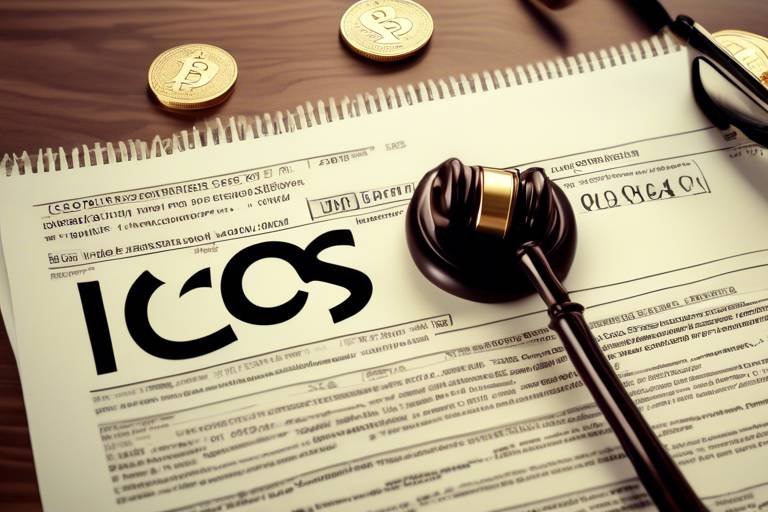How to Address Cross-Jurisdictional Issues in Crypto Regulation
In the ever-evolving world of cryptocurrency, the question of regulation is both a pressing and perplexing issue. As digital currencies continue to gain popularity and acceptance, the need for a cohesive regulatory framework becomes increasingly evident. However, the challenge lies in the fact that different jurisdictions have varying laws, policies, and enforcement mechanisms. This disparity can create a chaotic environment for businesses and consumers alike, making it essential to address these cross-jurisdictional issues head-on.
Imagine trying to play a game of soccer where each player is following different rules; it would be chaotic, right? The same analogy applies to cryptocurrency regulation across various jurisdictions. Without a unified approach, we risk stifling innovation and creating an environment where compliance becomes a daunting task for businesses. As we navigate through this complex landscape, it’s vital to explore the intricacies of regulation, the role of international organizations, and potential frameworks that can facilitate cooperation.
One of the first steps in addressing these challenges is recognizing the importance of a unified regulatory approach. A harmonized framework can not only foster innovation but also ensure consumer protection. When regulations are consistent across borders, businesses can operate more efficiently, and consumers can have greater confidence in the safety and legitimacy of their transactions. This is particularly crucial in the crypto space, where the rapid pace of technological advancement often outstrips the ability of regulators to keep up.
As we delve deeper into the challenges of cross-jurisdictional regulation, we must consider the role of international organizations. These bodies can serve as facilitators, helping to bridge the gap between different jurisdictions and promote collaboration. By establishing global regulatory standards, they can create a more predictable environment for businesses and consumers alike.
However, the road to a cohesive regulatory framework is fraught with challenges. Differing laws can create confusion and hinder enforcement efforts. Additionally, the fast-paced nature of cryptocurrency technology complicates regulatory efforts, as regulators often find themselves playing catch-up. To address these issues, we must analyze successful case studies of collaboration between jurisdictions. By learning from these examples, we can uncover valuable insights that can inform future regulatory strategies.
Exploring potential frameworks for cooperation is another crucial aspect of addressing cross-jurisdictional issues. Various models can be adopted by jurisdictions to achieve better alignment. For instance, jurisdictions could establish bilateral agreements that outline shared regulatory principles and enforcement mechanisms. These frameworks could pave the way for improved communication and collaboration, ultimately leading to more effective regulation.
In addition to regulatory frameworks, technological solutions can also play a significant role in aiding compliance across jurisdictions. Advancements in technology, such as blockchain analytics and automated compliance tools, can help regulators and businesses navigate the complex legal landscapes they face. By leveraging these tools, stakeholders can ensure they remain compliant while also fostering innovation.
Finally, it’s essential to recognize the role of industry stakeholders in shaping regulatory outcomes. Crypto exchanges, developers, and other players in the ecosystem have a critical responsibility to engage with regulators and advocate for fair regulations. By adopting best practices for compliance and employing effective advocacy and engagement strategies, these stakeholders can influence the development of regulations that not only protect consumers but also promote innovation.
- What are cross-jurisdictional issues in crypto regulation?
Cross-jurisdictional issues refer to the challenges that arise when different countries or regions have varying laws and regulations regarding cryptocurrency, leading to confusion and compliance difficulties for businesses. - Why is a unified regulatory approach important?
A unified regulatory approach helps foster innovation, ensures consumer protection, and creates a more predictable environment for businesses operating in the cryptocurrency space. - How can international organizations help in crypto regulation?
International organizations can facilitate cooperation among jurisdictions, establish global regulatory standards, and promote collaboration to address cross-jurisdictional challenges effectively. - What role do industry stakeholders play in regulation?
Industry stakeholders, including crypto exchanges and developers, can influence regulatory outcomes by engaging with regulators, advocating for fair regulations, and adopting best practices for compliance.

The Importance of a Unified Regulatory Approach
In the rapidly evolving world of cryptocurrency, a unified regulatory approach is not just beneficial; it's essential. Imagine trying to navigate a maze where each turn leads you to a different set of rules—confusing, right? That's exactly what many crypto businesses face today as they operate across various jurisdictions. A cohesive regulatory framework can serve as a guiding light, illuminating the path for innovation while ensuring that consumer protection remains a top priority.
When regulations are harmonized across borders, it creates a level playing field for all players in the crypto space. This means that startups can innovate without the fear of being stifled by conflicting laws. For instance, if a blockchain company wants to launch its platform in multiple countries, having a unified set of regulations simplifies the process. It allows for easier compliance checks and reduces the likelihood of legal pitfalls that could arise from misunderstanding local laws.
Moreover, a unified approach can enhance trust in the cryptocurrency ecosystem. When consumers know that there are standardized regulations in place, they feel more secure in their transactions. This trust is vital for the long-term sustainability of the crypto market. After all, would you invest your hard-earned money in a marketplace that seems chaotic and poorly regulated? Probably not! A well-regulated environment fosters confidence, encouraging more people to participate in the crypto economy.
Another significant advantage of a unified regulatory framework is the potential for international collaboration. Countries can work together to share insights, best practices, and even technological advancements that can enhance regulatory compliance. This collaboration can lead to the development of innovative solutions that benefit both regulators and businesses. For example, if one country develops a robust framework for anti-money laundering (AML) compliance, others can adopt similar measures, creating a ripple effect that strengthens the entire industry.
Ultimately, the importance of a unified regulatory approach cannot be overstated. It not only promotes innovation and consumer protection but also builds a foundation of trust and collaboration that is crucial for the future of cryptocurrency. As we move forward, it's essential for stakeholders—from regulators to industry players—to recognize the value of working together towards a common goal.
- Why is a unified regulatory approach necessary for cryptocurrency?
A unified regulatory approach is essential to ensure that businesses can operate smoothly across borders, fostering innovation while protecting consumers. - What are the benefits of harmonizing regulations?
Harmonizing regulations creates a level playing field, enhances trust among consumers, and allows for international collaboration. - How can international organizations help in this process?
International organizations can facilitate cooperation among jurisdictions, helping to establish global regulatory standards.

Challenges of Cross-Jurisdictional Regulation
Regulating cryptocurrency across different jurisdictions is akin to trying to herd cats—each cat (or jurisdiction, in this case) has its own personality, rules, and unpredictability. The rapid evolution of cryptocurrency technology presents a unique set of challenges that regulators must navigate. One of the primary hurdles is the existence of differing laws in various countries. Each jurisdiction may have its own definitions of what constitutes cryptocurrency, how it should be taxed, and what compliance measures are necessary. This patchwork of regulations creates a confusing environment for businesses operating internationally, often leading to compliance nightmares.
Moreover, the enforcement of regulations can be particularly tricky. Imagine a scenario where a cryptocurrency exchange is operating in multiple countries, each with its own regulatory framework. If one jurisdiction decides to crack down on a particular practice while another turns a blind eye, businesses find themselves in a precarious position, struggling to comply with conflicting requirements. This inconsistency can stifle innovation, as companies may be hesitant to invest in new technologies or services due to the fear of regulatory backlash.
Another significant challenge is the fast-paced nature of cryptocurrency technology. The speed at which new coins, tokens, and blockchain technologies emerge makes it difficult for regulators to keep up. By the time a regulatory framework is proposed, it may already be outdated, leaving gaps that can be exploited by bad actors. This is especially concerning in a space where security is paramount; vulnerabilities can lead to significant financial losses for consumers and businesses alike.
Furthermore, the global nature of cryptocurrency means that a single jurisdiction's regulations may be ineffective if not supported by others. For instance, if one country imposes strict regulations on cryptocurrency exchanges, those exchanges may simply relocate to a more favorable environment, rendering the original regulations moot. This phenomenon, known as regulatory arbitrage, can lead to a race to the bottom, where jurisdictions compete to attract businesses by lowering their regulatory standards.
Lastly, the lack of a cohesive regulatory framework can result in increased compliance costs for businesses. Companies may need to hire legal experts to navigate the complex web of regulations, diverting resources away from innovation and growth. This not only affects startups but also established companies looking to expand internationally. The need for a more streamlined approach to regulation has never been more critical, as it can foster a more secure and innovative environment for all stakeholders involved.
In summary, the challenges of cross-jurisdictional regulation in the cryptocurrency space are multifaceted. From differing laws and enforcement difficulties to the rapid pace of technological change and the risks of regulatory arbitrage, these obstacles can hinder the growth and development of the industry. A collaborative approach among jurisdictions, supported by international organizations, could pave the way for a more unified regulatory framework that promotes innovation while ensuring consumer protection.

The Role of International Organizations
International organizations stand at the forefront of shaping a cohesive framework for cryptocurrency regulation across the globe. With the rapid evolution of digital currencies, the need for a harmonized approach has never been more pressing. These organizations, such as the Financial Action Task Force (FATF) and the International Monetary Fund (IMF), play a pivotal role in establishing standards that transcend national borders. They not only provide guidance but also facilitate dialogue among countries, helping to bridge the regulatory gaps that often arise due to differing legal frameworks.
One of the main advantages of involving international organizations in cryptocurrency regulation is their ability to foster cooperation among jurisdictions. By bringing together regulators from various countries, these organizations can promote a shared understanding of the risks and challenges posed by cryptocurrencies. They can also encourage the development of best practices that can be adopted universally, thus enhancing compliance and security measures. For instance, the FATF has been instrumental in issuing recommendations that member countries are encouraged to implement, aimed at combating money laundering and terrorist financing in the crypto space.
Moreover, international organizations often conduct research and provide valuable insights into the implications of cryptocurrency on global financial systems. They can analyze trends, assess risks, and offer data-driven recommendations to help regulators make informed decisions. This data-centric approach is essential, as it allows for a more nuanced understanding of how cryptocurrencies operate and the potential impacts of regulation on innovation.
However, the effectiveness of international organizations in regulating cryptocurrencies is not without challenges. The diverse political landscapes and economic interests of member countries can sometimes hinder consensus-building. Additionally, the fast-paced nature of cryptocurrency technology means that regulations can quickly become outdated, necessitating continuous updates and revisions. To address these issues, organizations must remain agile and responsive, adapting their frameworks to keep pace with technological advancements.
In conclusion, international organizations are crucial players in the quest for effective cryptocurrency regulation. By fostering collaboration, providing research, and establishing standards, they can help create a more cohesive regulatory environment that encourages innovation while ensuring compliance and security. As the landscape of cryptocurrency continues to evolve, the role of these organizations will likely become even more significant, guiding jurisdictions toward a future where regulation and innovation coexist harmoniously.
- What is the role of international organizations in cryptocurrency regulation?
International organizations help establish global standards, promote cooperation among countries, and provide research and insights into the risks associated with cryptocurrencies.
- How do international organizations influence regulatory frameworks?
They issue recommendations and best practices that countries are encouraged to implement, facilitating a more uniform regulatory approach across jurisdictions.
- What challenges do international organizations face in crypto regulation?
Diverse political interests and the rapid pace of technological change can complicate consensus-building and the timely update of regulations.

Case Studies of Successful Collaboration
When it comes to navigating the complex world of cryptocurrency regulation, collaboration among jurisdictions is not just beneficial; it's essential. There have been notable instances where different countries and regulatory bodies have come together to create frameworks that not only promote compliance but also foster innovation. One of the most prominent examples is the collaboration between the United States and the European Union in the development of guidelines for Initial Coin Offerings (ICOs). This partnership allowed both regions to share insights and best practices, ultimately leading to a more robust regulatory environment that protects investors while encouraging technological advancement.
Another striking example can be seen in the Asia-Pacific region, where countries like Singapore and Australia have worked together to establish a regulatory sandbox. This initiative enables crypto startups to test their products in a controlled environment while adhering to a set of guidelines that ensure consumer protection and compliance. The sandbox has proven to be a breeding ground for innovation, allowing businesses to experiment with new technologies without the fear of regulatory backlash. Such collaborative efforts not only enhance the credibility of the cryptocurrency sector but also pave the way for a more unified approach to regulation.
Furthermore, the Financial Action Task Force (FATF) has played a pivotal role in promoting international cooperation. By setting global standards for combating money laundering and terrorist financing, the FATF encourages jurisdictions to align their regulations. This has led to a more cohesive global response to the challenges posed by cryptocurrency, as countries are now working together to ensure that their laws and enforcement mechanisms are compatible. The impact of such collaboration cannot be overstated; it creates a safer environment for users and builds trust in the cryptocurrency ecosystem.
In summary, these case studies illustrate that successful collaboration in crypto regulation is not just possible but necessary. By sharing knowledge and resources, jurisdictions can tackle the challenges posed by the fast-evolving nature of cryptocurrency. The lessons learned from these collaborations can serve as a blueprint for future initiatives, ensuring that the regulatory landscape remains conducive to innovation while safeguarding the interests of consumers.
- What are the key benefits of cross-jurisdictional collaboration in crypto regulation?
Collaborative efforts can lead to harmonized regulations, improved compliance standards, and enhanced investor protection, ultimately fostering innovation in the cryptocurrency space.
- How can international organizations aid in regulatory cooperation?
International organizations can facilitate dialogue, share best practices, and set global standards that encourage jurisdictions to align their regulations.
- What role do industry stakeholders play in shaping regulations?
Industry stakeholders, including exchanges and developers, are crucial in advocating for fair regulations and can collaborate with regulators to ensure that new laws are practical and effective.

Potential Frameworks for Cooperation
In the rapidly evolving world of cryptocurrency, establishing effective frameworks for cooperation among jurisdictions is not just beneficial; it's essential. Think of it like assembling a jigsaw puzzle where each piece represents a different regulatory approach. When these pieces fit together harmoniously, they create a clear picture of a well-regulated crypto landscape. Without this cooperation, we risk creating gaps that can lead to regulatory arbitrage, where businesses exploit inconsistencies in laws to their advantage.
One promising model involves the creation of multi-jurisdictional regulatory bodies. These bodies can serve as a central hub for information sharing, best practices, and joint enforcement actions. By pooling resources and expertise, jurisdictions can tackle issues that transcend borders. For instance, the Financial Action Task Force (FATF) has made strides in this area by promoting global standards for anti-money laundering (AML) and combating the financing of terrorism (CFT) in the crypto space. This kind of international collaboration can help ensure that all jurisdictions are on the same page, reducing the risk of illicit activities.
Another potential framework is the establishment of bilateral agreements between countries. These agreements can define how jurisdictions will cooperate on regulatory matters and share information about suspicious activities. Just as countries have treaties for extradition, similar agreements can be tailored for cryptocurrency regulation. Such measures can help build trust and facilitate smoother communication between regulators, which can lead to quicker responses to emerging threats.
Moreover, leveraging technology can create a robust foundation for cooperation. For example, using blockchain technology itself to create a transparent ledger of regulatory compliance can allow different jurisdictions to verify each other's activities without compromising sensitive information. This could enhance trust and reduce the administrative burden on businesses trying to comply with multiple regulations.
To wrap up, the potential frameworks for cooperation in cryptocurrency regulation are not just theoretical concepts; they are practical solutions that can lead to a more secure and innovative environment for all stakeholders involved. By embracing multi-jurisdictional bodies, bilateral agreements, and cutting-edge technology, we can work towards a cohesive regulatory landscape that benefits everyone.
- What are the main challenges of cross-jurisdictional regulation?
The main challenges include differing laws, enforcement difficulties, and the rapid pace of technological advancements in the crypto space. - How can international organizations help with crypto regulation?
International organizations can facilitate cooperation among jurisdictions, promote global regulatory standards, and share best practices. - What role do industry stakeholders play in shaping regulations?
Industry stakeholders, such as crypto exchanges and developers, can collaborate with regulators to ensure that regulations are fair and conducive to innovation.

Technological Solutions for Compliance
In the rapidly evolving world of cryptocurrency, compliance with varying regulations across jurisdictions can feel like navigating a labyrinth. Fortunately, technological solutions are emerging to help both regulators and businesses find their way through this complexity. These innovations not only streamline compliance processes but also enhance transparency and security in the crypto space.
One of the most significant technological advancements aiding compliance is Blockchain Analytics. Companies like Chainalysis and Elliptic provide tools that allow businesses to trace the flow of cryptocurrency transactions. By analyzing blockchain data, these platforms help organizations identify suspicious activities and ensure that they are not inadvertently facilitating money laundering or other illicit activities. This capability is essential for maintaining compliance with Anti-Money Laundering (AML) and Know Your Customer (KYC) regulations.
Moreover, Smart Contracts are revolutionizing how compliance is enforced. These self-executing contracts with the terms of the agreement directly written into code can automate compliance checks. For instance, a smart contract can be programmed to only execute a transaction if both parties meet specific regulatory requirements. This not only minimizes human error but also reduces the burden on businesses to constantly monitor compliance manually.
Another crucial aspect of technological solutions is the implementation of Regulatory Technology (RegTech). RegTech firms are developing software that helps organizations comply with regulations more efficiently. These tools often utilize machine learning and artificial intelligence to analyze vast amounts of data, identify compliance risks, and generate reports. This automation of compliance tasks allows businesses to focus on their core operations while ensuring they meet legal obligations.
Additionally, Digital Identity Solutions are becoming increasingly important in the crypto landscape. These solutions help verify the identity of users in a secure and efficient manner, which is vital for KYC compliance. By using biometric data, digital ID platforms can provide a higher level of security while making the onboarding process smoother for users. This not only enhances user experience but also helps businesses adhere to regulatory requirements without sacrificing efficiency.
As we look towards the future, it's clear that the integration of technology into compliance processes is not merely an option; it is a necessity. By leveraging these technological solutions, businesses can navigate the intricate web of cross-jurisdictional regulations more effectively. The ultimate goal is to create an environment where innovation thrives alongside robust compliance measures, ensuring a safe and secure cryptocurrency ecosystem for all stakeholders involved.
In summary, the intersection of technology and compliance in the cryptocurrency realm is a dynamic and promising landscape. As we continue to witness advancements in blockchain analytics, smart contracts, RegTech, and digital identity solutions, the potential for a more harmonized and efficient regulatory framework becomes increasingly attainable.
- What is the role of blockchain analytics in compliance?
Blockchain analytics helps businesses trace transactions and identify suspicious activities, ensuring compliance with regulations like AML and KYC. - How do smart contracts enhance compliance?
Smart contracts automate compliance checks by executing transactions only when regulatory conditions are met, reducing human error. - What is RegTech?
RegTech refers to technology solutions that help organizations comply with regulations more efficiently, often using AI and machine learning. - Why are digital identity solutions important?
Digital identity solutions enhance KYC compliance by securely verifying user identities, improving user experience while meeting regulatory requirements.

The Role of Industry Stakeholders
In the ever-evolving landscape of cryptocurrency, industry stakeholders play a crucial role in shaping regulatory outcomes. These stakeholders include crypto exchanges, developers, investors, and even users, all of whom contribute to the ecosystem's vibrancy and complexity. As the regulatory environment becomes more intricate, the need for these participants to engage with regulators and advocate for sensible policies becomes more pronounced. Think of it as a dance; each player must move in sync to create a harmonious outcome that benefits everyone involved.
One of the primary responsibilities of industry stakeholders is to ensure that they operate within the legal frameworks established by regulators. This means staying informed about the latest regulations, understanding their implications, and adapting their business practices accordingly. For example, a crypto exchange must implement robust Know Your Customer (KYC) and Anti-Money Laundering (AML) measures to comply with local laws. Failure to do so can result in hefty fines and damage to their reputation. Therefore, stakeholders must not only comply but also advocate for regulations that are fair and promote innovation.
Moreover, collaboration among stakeholders can lead to the development of best practices that benefit the entire industry. When exchanges, developers, and other players come together to share insights and experiences, they create a collective knowledge base that can inform regulatory discussions. This is where the power of community comes into play. By forming alliances, stakeholders can present a united front to regulators, making it clear that they are committed to fostering a secure and compliant environment.
The role of industry stakeholders doesn't end with compliance and collaboration; they must also engage in proactive advocacy. This involves communicating their needs and concerns to regulators effectively. Stakeholders can participate in public consultations, submit position papers, and even engage in direct dialogue with regulatory bodies. By doing so, they can influence the development of regulations that not only protect consumers but also allow for the growth and innovation that the crypto industry thrives on.
It's essential to recognize that the relationship between regulators and industry stakeholders is not adversarial; rather, it should be viewed as a partnership. Regulators need the insights and expertise of industry players to create effective policies, while stakeholders require a regulatory framework that enables them to operate successfully. This symbiotic relationship can lead to a more stable and innovative cryptocurrency ecosystem.
As the industry continues to mature, the role of stakeholders will only become more significant. They must remain agile, ready to adapt to new regulations and technologies, while also advocating for their interests. The future of cryptocurrency regulation hinges on this collaborative effort, where all parties work together to create a regulatory landscape that is both effective and supportive of innovation.
- What are the main responsibilities of industry stakeholders in crypto regulation? Industry stakeholders must ensure compliance with regulations, engage in advocacy, and collaborate to establish best practices.
- How can stakeholders influence regulatory outcomes? By participating in public consultations, submitting position papers, and engaging in direct dialogue with regulators.
- Why is collaboration among stakeholders important? Collaboration helps create a unified front, sharing insights that can inform regulatory discussions and lead to better policies.

Best Practices for Compliance
In the ever-evolving landscape of cryptocurrency, ensuring compliance with regulations is not just a legal obligation but a pathway to building trust and credibility within the market. As businesses navigate the complexities of cross-jurisdictional regulations, adopting best practices becomes paramount. One of the most effective strategies is to establish a robust compliance framework that is adaptable to various regulatory environments. This framework should include comprehensive risk assessments, allowing companies to identify and mitigate potential compliance risks before they escalate into larger issues.
Moreover, organizations should invest in continuous education and training for their teams. By keeping staff updated on the latest regulatory changes and compliance requirements, businesses can foster a culture of compliance that permeates every level of the organization. This proactive approach not only minimizes the risk of violations but also enhances the overall operational efficiency of the company.
Utilizing technological solutions is another best practice that can significantly streamline compliance efforts. For example, automated compliance software can help track regulatory changes across jurisdictions, ensuring that businesses remain informed and compliant without the burden of manual monitoring. These tools can also assist in maintaining accurate records, which is crucial for audits and regulatory reviews.
Additionally, fostering open communication with regulators can lead to a better understanding of compliance expectations. Engaging in dialogue not only helps clarify ambiguous regulations but also allows businesses to express their concerns and suggest practical solutions. By building these relationships, companies can position themselves as responsible industry players committed to upholding regulatory standards.
Finally, it’s essential to stay informed about industry best practices and trends. Joining industry associations and participating in forums can provide valuable insights and resources that help companies navigate the regulatory landscape more effectively. By collaborating with peers, organizations can share experiences and strategies that have proven successful in achieving compliance.
In summary, the best practices for compliance in the cryptocurrency space revolve around establishing a solid framework, investing in education, leveraging technology, maintaining open lines of communication with regulators, and staying informed about industry trends. By implementing these strategies, businesses can not only comply with regulations but also thrive in a competitive market.
- What are the key components of a compliance framework? A compliance framework typically includes risk assessments, policies and procedures, training programs, and monitoring systems to ensure adherence to regulations.
- How can technology aid in compliance efforts? Technology can automate monitoring processes, track regulatory changes, and maintain accurate records, making compliance more efficient and less prone to human error.
- Why is communication with regulators important? Open communication helps clarify regulatory expectations and allows businesses to address concerns, fostering a collaborative relationship that benefits both parties.
- What role do industry associations play in compliance? Industry associations provide resources, share best practices, and facilitate networking opportunities, helping businesses stay informed and compliant.

Advocacy and Engagement Strategies
In the rapidly evolving world of cryptocurrency, advocacy and engagement with regulators are not just beneficial; they are essential for shaping a fair and effective regulatory environment. Industry stakeholders—ranging from crypto exchanges to developers—must take proactive steps to ensure their voices are heard. But how can they effectively advocate for their interests while also promoting a regulatory framework that fosters innovation? Let’s dive into some key strategies.
First and foremost, building relationships with regulators is crucial. This involves more than just occasional meetings; it requires ongoing dialogue and a genuine effort to understand the regulatory landscape. Stakeholders should seek to establish themselves as trusted partners in the regulatory process. By sharing insights, data, and expertise, they can help regulators understand the complexities of the cryptocurrency market. This collaboration can lead to more informed decision-making and ultimately, regulations that are both effective and conducive to innovation.
Another important strategy is participating in public consultations. Regulatory bodies often seek input from industry stakeholders when drafting new regulations. By actively engaging in these consultations, stakeholders can voice their concerns, provide valuable feedback, and suggest alternative approaches that align with their operational realities. It’s an opportunity to influence the conversation and advocate for regulations that reflect the needs of the industry.
Moreover, forming or joining industry associations can amplify advocacy efforts. These organizations provide a platform for collective action, allowing stakeholders to pool their resources and present a united front. By collaborating with others in the industry, stakeholders can leverage their combined knowledge and experience to advocate for more favorable regulations. This collaborative approach can be particularly effective when addressing complex issues that require a multifaceted perspective.
In addition to direct engagement with regulators, stakeholders should also consider educating the public about cryptocurrency and its benefits. Public perception can significantly influence regulatory decisions. By demystifying cryptocurrency and highlighting its potential to drive economic growth, create jobs, and enhance financial inclusion, stakeholders can foster a more supportive environment for innovation. This can be achieved through various channels, including social media campaigns, educational workshops, and community outreach programs.
Lastly, stakeholders must stay informed about regulatory developments and be prepared to adapt their strategies accordingly. The cryptocurrency landscape is dynamic, and regulations can change rapidly. By keeping a pulse on regulatory trends, stakeholders can anticipate challenges and seize opportunities to advocate for their interests effectively. This proactive approach will not only help them navigate the regulatory landscape but also position them as leaders in the industry.
In conclusion, advocacy and engagement strategies are vital for industry stakeholders looking to influence cryptocurrency regulation. By building relationships with regulators, participating in public consultations, joining industry associations, educating the public, and staying informed, stakeholders can play a pivotal role in shaping a regulatory framework that promotes innovation while ensuring compliance and security.
- What is the significance of advocacy in cryptocurrency regulation?
Advocacy helps ensure that the voices of industry stakeholders are heard in the regulatory process, leading to more informed and balanced regulations. - How can industry stakeholders engage with regulators?
Stakeholders can engage through public consultations, direct meetings, and by forming industry associations to present a united front. - Why is public education important in the regulatory landscape?
Educating the public can positively influence public perception and, consequently, regulatory decisions, fostering a more supportive environment for cryptocurrency innovation. - What role do industry associations play in advocacy?
Industry associations provide a platform for collective action, allowing stakeholders to pool resources and present a unified voice to regulators.
Frequently Asked Questions
- What are the main challenges of regulating cryptocurrency across different jurisdictions?
Regulating cryptocurrency across different jurisdictions is like trying to herd cats! Each country has its own set of laws and regulations, which can lead to inconsistencies and confusion. Some of the main challenges include differing legal frameworks, enforcement difficulties, and the rapid evolution of technology that outpaces regulatory efforts. This creates a complex environment for both regulators and businesses trying to comply.
- Why is a unified regulatory approach important in the crypto space?
A unified regulatory approach is crucial because it helps create a level playing field for all players in the cryptocurrency market. When regulations are harmonized, it fosters innovation while ensuring that consumer protection is prioritized. This is essential for building trust among users and investors, which ultimately drives growth in the industry.
- How can international organizations help with crypto regulation?
International organizations can act as facilitators in the complex world of crypto regulation. They can help establish global standards, promote cooperation among jurisdictions, and provide a platform for dialogue. By working together, countries can share best practices and develop a cohesive regulatory framework that addresses the unique challenges posed by cryptocurrencies.
- What are some successful case studies of collaboration in crypto regulation?
There are several inspiring case studies where jurisdictions have successfully collaborated on crypto regulation. For instance, the European Union has made strides in creating a unified regulatory framework that enhances cooperation among member states. These collaborations have led to effective regulatory outcomes that benefit both consumers and businesses, showcasing the power of teamwork in tackling complex issues.
- What technological solutions exist to aid compliance in crypto regulation?
Technology is a game changer when it comes to compliance in cross-jurisdictional regulation. Tools like blockchain analytics, automated reporting systems, and compliance software can help businesses and regulators navigate the complex legal landscape. These advancements not only streamline compliance processes but also enhance transparency and accountability in the cryptocurrency market.
- What role do industry stakeholders play in shaping crypto regulations?
Industry stakeholders, including crypto exchanges, developers, and investors, have a significant impact on the regulatory landscape. By actively engaging with regulators and advocating for fair regulations, they can help shape policies that foster innovation while ensuring consumer protection. Collaboration between industry players and regulators is essential for creating a balanced approach to crypto regulation.
- What are best practices for compliance in the cryptocurrency industry?
Adopting best practices for compliance is vital for businesses operating in the cryptocurrency space. Some essential strategies include staying informed about regulatory changes, implementing robust internal controls, and conducting regular audits. By prioritizing compliance, businesses can mitigate risks and build trust with their users, creating a safer environment for everyone involved.
- How can industry players effectively engage with regulators?
Effective engagement with regulators is all about communication! Industry players should focus on building relationships, sharing insights, and providing feedback on proposed regulations. By presenting their needs and concerns in a constructive manner, they can influence the development of fair regulations that benefit both the industry and consumers.



















